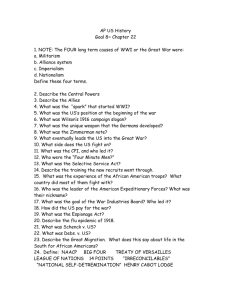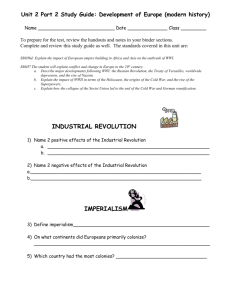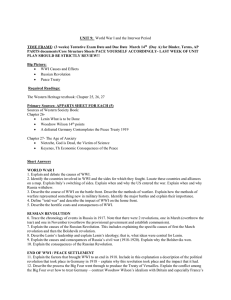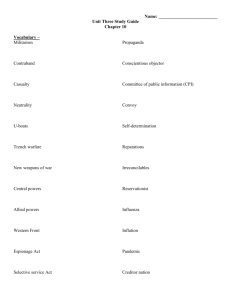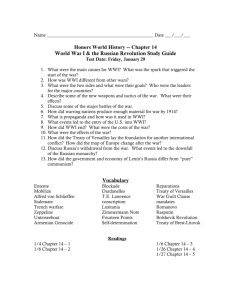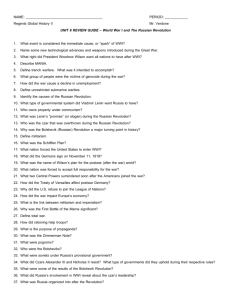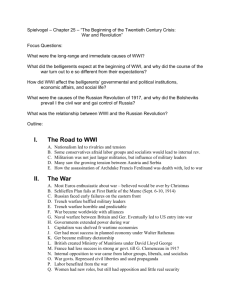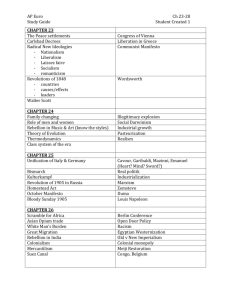Unit 9 plan AP Euro _2_
advertisement
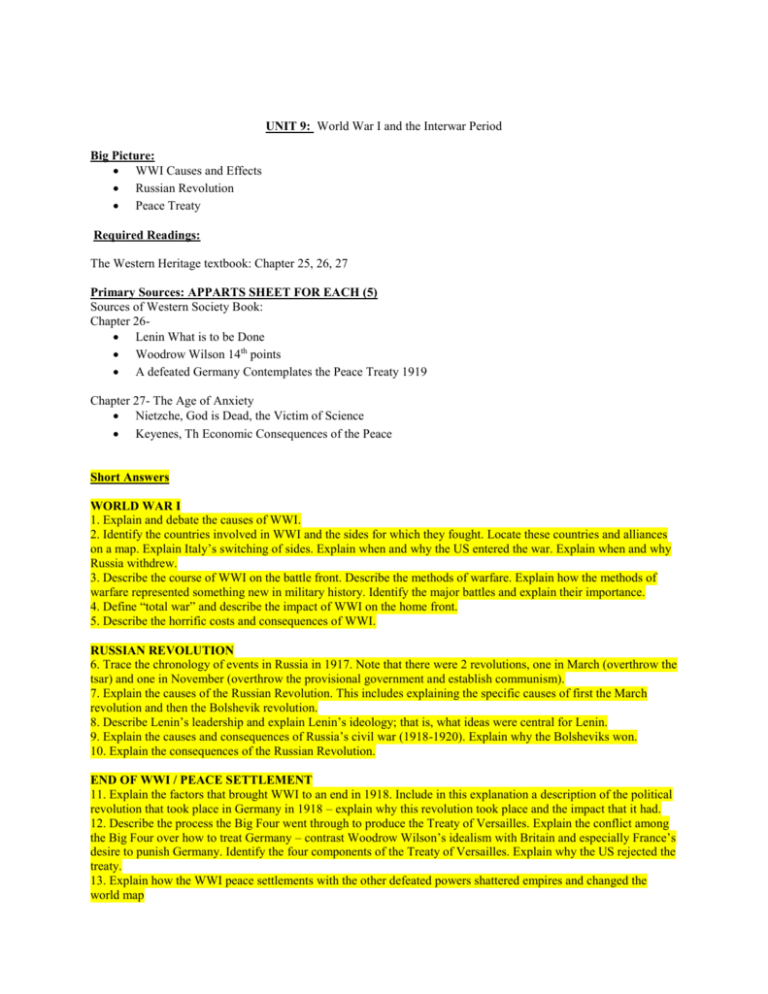
UNIT 9: World War I and the Interwar Period Big Picture: WWI Causes and Effects Russian Revolution Peace Treaty Required Readings: The Western Heritage textbook: Chapter 25, 26, 27 Primary Sources: APPARTS SHEET FOR EACH (5) Sources of Western Society Book: Chapter 26 Lenin What is to be Done Woodrow Wilson 14th points A defeated Germany Contemplates the Peace Treaty 1919 Chapter 27- The Age of Anxiety Nietzche, God is Dead, the Victim of Science Keyenes, Th Economic Consequences of the Peace Short Answers WORLD WAR I 1. Explain and debate the causes of WWI. 2. Identify the countries involved in WWI and the sides for which they fought. Locate these countries and alliances on a map. Explain Italy’s switching of sides. Explain when and why the US entered the war. Explain when and why Russia withdrew. 3. Describe the course of WWI on the battle front. Describe the methods of warfare. Explain how the methods of warfare represented something new in military history. Identify the major battles and explain their importance. 4. Define “total war” and describe the impact of WWI on the home front. 5. Describe the horrific costs and consequences of WWI. RUSSIAN REVOLUTION 6. Trace the chronology of events in Russia in 1917. Note that there were 2 revolutions, one in March (overthrow the tsar) and one in November (overthrow the provisional government and establish communism). 7. Explain the causes of the Russian Revolution. This includes explaining the specific causes of first the March revolution and then the Bolshevik revolution. 8. Describe Lenin’s leadership and explain Lenin’s ideology; that is, what ideas were central for Lenin. 9. Explain the causes and consequences of Russia’s civil war (1918-1920). Explain why the Bolsheviks won. 10. Explain the consequences of the Russian Revolution. END OF WWI / PEACE SETTLEMENT 11. Explain the factors that brought WWI to an end in 1918. Include in this explanation a description of the political revolution that took place in Germany in 1918 – explain why this revolution took place and the impact that it had. 12. Describe the process the Big Four went through to produce the Treaty of Versailles. Explain the conflict among the Big Four over how to treat Germany – contrast Woodrow Wilson’s idealism with Britain and especially France’s desire to punish Germany. Identify the four components of the Treaty of Versailles. Explain why the US rejected the treaty. 13. Explain how the WWI peace settlements with the other defeated powers shattered empires and changed the world map TERMS TO KNOW WORLD WAR I 1. MAIN causes: militarism, alliances, imperialism, nationalism 2. Triple Alliance 3. Triple Entente 4. Central Powers 5. Allied Powers 6. Balkans 7. Congress of Berlin (1878) 8. Bosnia & Herzegovina 9. Archduke Francis Ferdinand 10. Black Hand 11. Gavrilo Princip 12. ultimatum 13. mobilization 14. Schlieffen Plan 15. Battle of the Marne 16. western front 17. trench warfare 18. no man’s land 19. Somme & Verdun (1916) 20. stalemate 21. eastern front 22. Lusitania 23. unrestricted submarine warfare 24. total war 25. rationing 26. propaganda 27. Walter Rathenau 28. War Raw Materials Board 29. Hindenburg & Ludendorff 30. Auxiliary Service Law RUSSIAN REVOLUTION 31. Tsar Nicholas II (r. 1894-1917) 32. Duma 33. Rasputin 34. March Revolution (March 1917) 35. Alexander Kerensky 36. provisional government 37. Petrograd Soviet 38. Army Order No. 1 39. Bolshevik Revolution (Nov. 1917) 40. V.I. Lenin 41. Bolsheviks 42. Mensheviks 43. Leon Trotsky 44. Treaty of Brest-Litovsk (Mar. 1918) 45. Constituent Assembly 46. Russian civil war – Whites vs. Reds (1918-20) 47. war communism 48. Cheka END OF WWI / PEACE SETTLEMENT 49. second Battle of the Marne (July 1918) 50. armistice (11/11/1918 @ 11 a.m.) 51. German Revolution (Nov. 1918) 52. German Social Democrats 53. Karl Liebknicht & Rosa Luxemburg 54. Paris Peace Conference (January 1919) 55. Big Four 56. Woodrow Wilson 57. David Lloyd George 58. Georges Clemenceau 59. Fourteen Points 60. self-determination 61. League of Nations 62. Treaty of Versailles (June 28, 1919) 63. League of Nations mandates 64. war guilt clause 65. reparations 66. Henry Cabot Lodge
